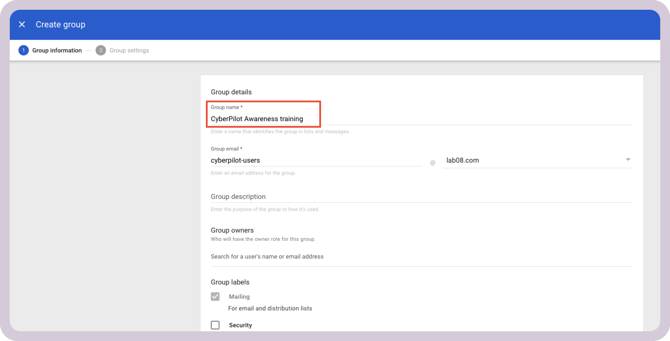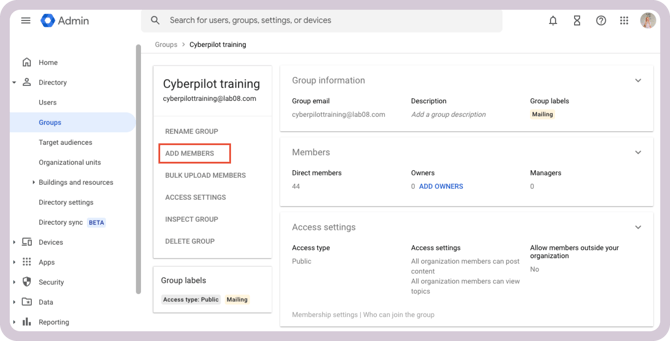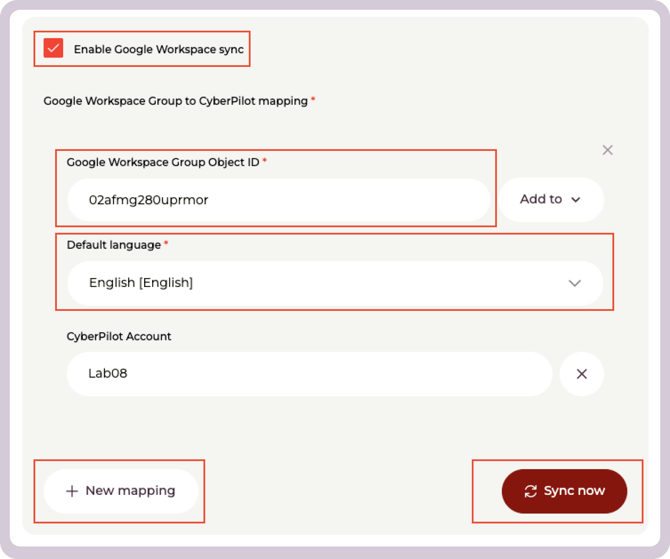Google AD and Single Sign-On
To integrate your Google Workspace with CyberPilot for automated user management and secure Single Sign-On (SSO), you’ll need to set up a few things in the Google Cloud Console
This guide will walk you through the entire setup – from creating a service account to configuring the necessary APIs and OAuth credentials.
By completing these steps, you’ll enable CyberPilot to securely sync user and group data from your Google Workspace environment and allow users to log in to the CyberPilot platform using their Google accounts.
Let’s get started 👇
Part 1: Notify your Customer Success Manager
The first step is telling your Customer Success Manager that you would like to set up Google AD and SSO. Your Customer Success Manager will give your account a subdomain, and then you'll be able to continue with the setup process.
Part 2: Generate Google Config
To integrate Google Workspace with CyberPilot, you'll need to create a service account in Google Cloud Console. This enables CyberPilot to securely manage users and groups via API.
1. Create a project in Google Cloud Console
-
Click the project dropdown and select "New Project"
-
Name it (e.g., CyberPilot) and click Create

2. Enable Admin SDK API
-
In your new project, go to APIs & Services > Library
-
Search for Admin SDK
-
Click it, then click Enable


3. Create a Service Account
-
Navigate to IAM & Admin > Service Accounts
-
Click Create Service Account
-
Name it, then click Create and Continue
-
Grant the role: Service Account Token Creator
-
Click Done



4. Generate a Private Key
-
Click on the service account you just created
-
Go to the Keys tab
-
Click Add Key > Create New Key
-
Choose JSON format
This will download a .json file containing:
client_idclient_emailprivate_key

5. Delegate Domain-Wide Authority
-
Under the service account settings, go to the Details tab
-
Click "Show Domain-Wide Delegation" and enable it
-
Note the Client ID – you’ll need it in the next step
6. Authorize API Access in Google Admin Console
-
Go to: https://admin.google.com (requires super admin)
-
Navigate to: Security > Access and data control > API Controls > Domain-wide Delegation
-
Click "Add new"
-
Enter the Client ID from your service account
-
Add the following scopes:
DIRECTORY_USER_READONLY = 'https://www.googleapis.com/auth/admin.directory.user.readonly',DIRECTORY_GROUPS_READONLY = 'https://www.googleapis.com/auth/admin.directory.group.readonly',DIRECTORY_GROUP_MEMBERS_READONLY = 'https://www.googleapis.com/auth/admin.directory.group.member.readonly'
- Click Save
7. Add Credentials to CyberPilot
Use the .json file you downloaded in Step 4.
Note that the private key from the json file looks like"private_key": "-----BEGIN PRIVATE KEY-----\nMIIEv….
you need to insert only
-----BEGIN PRIVATE KEY-----MIIEv without the \n
Part 3: Set Up and Manage Google Groups
You need to define which users will be synced to CyberPilot.
This is done through Google Groups. CyberPilot uses these groups to automatically identify and manage which users should be added or removed from your CyberPilot account.
1. Create or Select a Google Group
-
Go to your Google Admin Console
-
Navigate to Directory > Groups
-
Click Create Group
-
Enter a clear and descriptive name. For example:
-
Click Create

Tip: Each Google Group represents a set of users you want CyberPilot to sync.
You can have multiple groups if you want to manage access levels separately (for example, users in groups or branches).
2. Add Members to the Group
-
Open the group you just created
-
Click Add Members
-
Enter the email addresses of the users you want to include
-
Assign each as Member, Manager, or Owner

CyberPilot automatically syncs members of the group.
Managers and owners are included only if they are also listed as members.
You can update group membership at any time, and CyberPilot will automatically reflect those changes during the next sync.
3. Fetch the Group ID
Each Google Group has a unique Group ID that CyberPilot uses to identify which group(s) should be synced.
You’ll need to copy this ID and add it to your CyberPilot configuration.
Follow these steps:
-
Go to the Google Admin Console
-
Open Directory > Groups
-
Find and select the group you want to use
-
Look at the URL in your browser – the Group ID is included there
Example URL:
https://admin.google.com/ac/groups/1234567890abcdef/details
In this example, the Group ID is:
1234567890abcdefYou’ll need to repeat this process for each group you plan to sync with CyberPilot. Copy and paste each Group ID into the CyberPilot integration settings during setup.
Part 4: Add the Group in CyberPilot
Once you have your Group Object ID, you can configure the mapping inside CyberPilot.
-
Log in to your CyberPilot account
-
Go to Settings > Account
-
Click the Integrations tab
-
Select Google integration
-
Under Google Config, select User Management
-
Upload Private key JSON file to import the configuration you did in Part 2.
-
Check Enable Google Workspace sync
-
Fill in the following fields:
-
Google Workspace Group Object ID – paste the ID you copied from the Google Admin Console
-
Select Add to to allow specific mappings to CyberPilot objects
-
Default language – select the language new users should have
-
-
Under Google Workspace Group to CyberPilot mapping, click + New mapping if you want to setup additional group mappings to branches or CyberPilot groups
-
Click Sync now to start the synchronization immediately
After syncing, all users in the specified Google Group will automatically appear in your CyberPilot user list. Removing a user from the group will remove their access in CyberPilot during the next sync.

Part 5: Configure Google as SSO
This section enables users to log in to CyberPilot using their Google accounts via SSO.
1. Open Google Cloud Console Credentials
-
Select the same project you created earlier
2. Enable Required APIs
Navigate to APIs & Services > Library, then enable the following:
-
Google+ API (sometimes needed for user profile info)
-
OAuth2 APIs
-
Admin SDK (if needed for directory access)
3. Create OAuth 2.0 Credentials
-
Go to APIs & Services > Credentials
-
Click + Create Credentials > OAuth 2.0 Client ID
-
Select Web application
-
Give it a name (e.g., CyberPilot SSO)
4. Set Redirect URIs
-
Under Authorized redirect URIs, add the URI your app will handle after login. It's important you replace *subdomain* in the URI to the subdomain set in the CP-app. You'll find it under "Account" - "General infomation"
Example format:https://login.app.cyberpilot.io/realms/*subdomain*/broker/google-sso/endpoint
-
Save and copy credentials. Add to CyberPilot


Still have a question?
Contact us at support@cyberpilot.io
